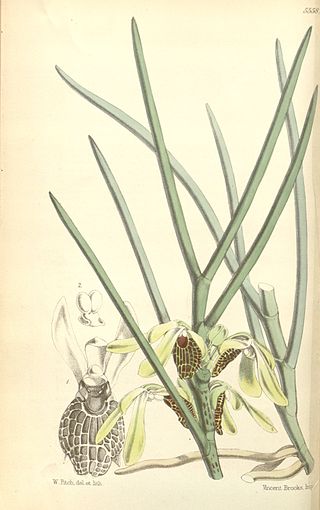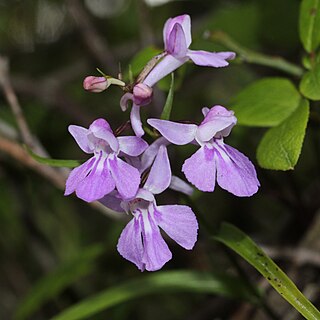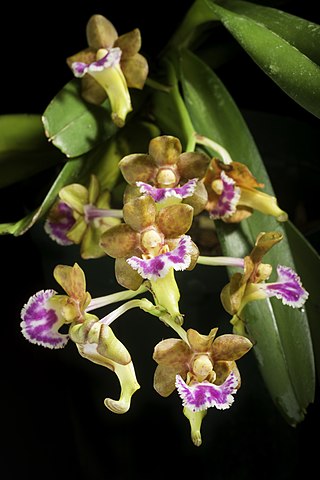Neofinetia was a genus of flowering plants from the orchid family, Orchidaceae, that is now regarded as a synonym of Vanda . It contained three species and was distributed in China, Korea, and Japan. [1]
Contents

Neofinetia was a genus of flowering plants from the orchid family, Orchidaceae, that is now regarded as a synonym of Vanda . It contained three species and was distributed in China, Korea, and Japan. [1]

The type species was introduced to the West from Japan by Carl Peter Thunberg in 1784, and placed in the genus Orchis . In 1925 H. H. Hu created Neofinetia as a monotypic genus. Neofinetia is named in honor of Achille Eugène Finet, a French botanist and author of Contributions a la Flore de L'Asie Orientale. The Greek prefix neo , (new) was added to distinguish it from another plant genus named earlier to honor Finet. [1]
In horticulture, Neofinetia was abbreviated as Neof. In the last part of the 20th century, it gained a great deal of attention in hybrid programs with other vandaceous orchids, thanks to its relative hardiness, scent, compact size, and above all, ease of culture.[ citation needed ] The names below are all obsolete, since Neofinetia is now synonymous with Vanda. For example, × Aeridofinetia is now × Aeridovanda.

In the botanical classification of plants, Aeridinae Pfitzer is a subtribe of the tribe Vandeae whose representatives all have a monopodial growth habit and do not possess pseudobulbs.

Vanda, abbreviated in the horticultural trade as V., is a genus in the orchid family, Orchidaceae. There are 90 species, and the genus is commonly cultivated for the marketplace. This genus and its allies are considered to be among the most specifically adapted of all orchids within the Orchidaceae. The genus is highly prized in horticulture for its showy, fragrant, long-lasting, and intensely colorful flowers. Vanda species are widespread across East Asia, Southeast Asia, and New Guinea, with a few species extending into Queensland and some of the islands of the western Pacific.

Aerides, known commonly as cat's-tail orchids and fox brush orchids, is a genus belonging to the orchid family. It is a group of tropical epiphyte orchids that grow mainly in the warm lowlands of tropical Asia from India to southern China to New Guinea. They are valued in horticulture for their racemes of showy, fragrant, colorful flowers.

Holcoglossum (Holc.) is a genus of orchids, in the family Orchidaceae. It is native from Assam through mainland China to Taiwan and Indo-China.

Galearis is a genus of the orchid family (Orchidaceae) native to North America and eastern Asia. It contains about ten recognized species. The family name comes from the Greek word orchis ('testicle'), in reference to the shape of the root.

Rhynchostylis is a genus in the orchid family (Orchidaceae), closely allied to the genus Vanda and comprising four currently accepted species native to the Indian Subcontinent, China, Indochina, Malaysia, Indonesia and the Philippines.

Luisia, commonly known as velvet orchids or 钗子股属 , is a genus of epiphytic or lithophytic orchids in family Orchidaceae. Plants in this genus have flattened roots, long leafy stems, narrow, thick, leathery leaves and short-lived flowers that open sporadically. There are about forty species found from tropical and subtropical Asia to the Western Pacific.

Ponerorchis is a genus of Asian terrestrial tuberous orchids. It is native to temperate Eurasia, from Poland to Japan, to the north of the Indian subcontinent and to northern Indochina.

Aerides falcata is a species of epiphytic orchid native to Yunnan, Vietnam, Thailand, Laos, Cambodia, Myanmar.

Vanda flabellata is a species of epiphytic orchid native to the Chinese province Yunnan, Laos, Vietnam and Thailand. It was erroneously reported to occur in Myanmar.

Chamaegastrodia is a genus of flowering plants from the orchid family, Orchidaceae. Three species are currently recognized, all native to eastern Asia and the Himalayas.

Yoania is a genus of flowering plants from the orchid family, Orchidaceae.

Oreorchis is a genus of flowering plants from the orchid family, Orchidaceae. It is native to Asia. Species currently accepted as of June 2014:

Papilionanthe is a genus of flowering plants from the orchid family, Orchidaceae. It is native to Southeast Asia, southern China, and the Indian Subcontinent.

Vanda falcata, also known as 风兰 in Chinese, 풍란 (pungnan) in Korean, 風蘭 (fūran) in Japanese, or the wind orchid in English, is a species of orchid found in China, Korea, and Japan. It was formerly classified in the genus Neofinetia.

Vanda ampullacea is a perennial epiphytic orchid found in southeast Asia from Nepal to China and India, including the eastern Himalayas. It has had various classifications, initially called Aerides ampullacea by William Roxburgh when it was first described in 1814. It was most recently reclassified in 2012 during a taxonomic revision of Vanda. In 1868, one if its cultivars received a First Class Certificate from the Royal Horticultural Society.

Vanda falcata subsp. xichangensis is a subspecies of Vanda falcata. It is an epiphytic orchid native to Southwest Sichuan, China.
![]() Media related to Neofinetia at Wikimedia Commons
Media related to Neofinetia at Wikimedia Commons